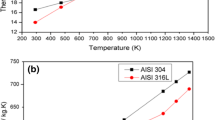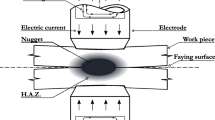Abstract
Resistance spot welding (RSW) involves joining of contacting surfaces by heat generated by resistance to electric current. The process is swift and finds demand in automobile industries for mass production. In spite of all the assets of the process, it yields a poor quality welds and inferior weld strength at the inner region of the joint interface. This may be improved by accurate setting of control parameters. The objective of this study is to determine the effect of various control parameters like electrode tip diameter, welding current, and heating cycle on the nugget size and tensile shear strength of dissimilar metal spot welding of 2-mm-thick AISI 316L austenitic stainless steel and 2205 Duplex Stainless Steel sheets. The Taguchi’s L27 orthogonal array (OA) design is selected to conduct the experimental spot welding trials on the dissimilar materials. Subsequently, the specimens are examined usinganalysis of variance (ANOVA) technique to customize optimal parameter setting to obtain high tensile strength and favorable weld quality characteristics. The results reveal that welding current is the most dictating factor to achieve highest tensile strength with superior weld quality. Also, weld samples are prepared for metallographic examination from cross section areas of resistance spot welds to examine microstructure changes and ferrite content measurement in different regions of weld nugget. The microstructure examination shows that the weld nugget consists of ferrite and austenite and ferrite and there is no precipitate of detrimental phases in the weldment.
Similar content being viewed by others
References
Thomson E (1886) Electrical world. McGraw-Hill Publishing Company, New York, pp 307–309
Dancette S, Fabregue D, Massardier V, Merlin J, Dupuy T, Bouzekri M (2011) Experimental and modeling investigation of the failure resistance of advanced high strength steels spot welds. Eng Fract Mech 78:2259–2272
Zhang W, Sun D, Han L, Li Y (2015) Optimised design of electrode morphology for novel dissimilar resistance spot welding of aluminium alloy and galvanised high strength steel. Mater Des 85:461–470
Campilho RDSG, Pinto AMG, Banea MD, Silva LFMD (2012) Optimization study of hybrid spot-welded/bonded single-lap joints. International Journal of Adhesion & Adhesives 37:86–95
Hamidinejad SM, Kolahan F, Kokabi AH (2012) The modeling and process analysis of resistance spot welding on galvanized steel sheets used in car body manufacturing. Mater Des 34:759–767
Thakur AG, Nandedkar VM (2010) Application of Taguchi method to determine resistance spot welding conditions of austenitic stainless steel AISI 304. J Sci Ind Res 69:680–683
Bharatha P, Sridhar VG, Senthil kumar M (2014) Optimization of 316 stainless steel weld joint characteristics using Taguchi technique. Procedia Engineering 97:881–891
Shafee S, Naik BB, Sammaiaha K (2015) Resistance spot weld quality characteristics improvement by Taguchi method. Materials Today: Proceedings 97:2595–2604
Ugur Eşme (2009) Application of Taguchi Method for the Optimization of Resistance Spot Welding Process. The Arabian Journal for Science and Engineering 34:519–528
Rahmani M, Eghlimi A, Shamanian M (2014) Evaluation of microstructure and mechanical properties in dissimilar austenitic/super duplex stainless steel joint. J Mater Eng Perform 23(10):3745–3753
Bhattacharya A, Kumar R (2016) Dissimilar joining between austenitic and duplex stainless steel in double-shielded GMAW: a comparative study. Mater Manuf Process 31:300–310
Devendranath Ramkumar K, Singh A, Raghuvanshi S, Bajpai A, Solanki T, Arivarasu M, Arivazhagan N, Narayanan S (2015) Metallurgical and mechanical characterization of dissimilar welds of austenitic stainless steel and super-duplex stainless steel – a comparative study. J Manuf Process 19:212–232
Aslanlar S, Ogur A, Ozsarac U, Ilhan E, Demir Z (2007) Effect of welding current on mechanical properties of galvanized chromided steel sheets in electrical resistance spot welding. J Mater Des 28:2–7
Aslanlar S (2006) The effect of nucleus size on mechanical properties in electrical resistance spot welding of sheets used in automotive industry. J. Mater. Des. 27:125–126
Palmer TA, Elmer JW, Babu SS (2004) Observations of ferrite/austenite transformations in the heat affected zone of 2205 duplex stainless steel spot welds using time resolved X-ray diffraction. Mater Sci Eng A 374(1–2):307–321
Yang WH, Tarng YS (1998) Design optimization of cutting parameters for turning operations based on the Taguchi method. J Mater Process Technol 84:122–129
Xavi MA, Adithan M (2009) Determining the influence of cutting fluids on tool wear and surface roughness during turning of AISI 304 austenitic stainless steel. J Mater Process Technol 209:900–909
Gideon B, Ward L, Biddle G (2008) Duplex stainless steel welds and their susceptibility to intergranular corrosion. Journal of Minerals & Materials Characterization & Engineering 7(3):247–263
Elmer JW, Allen SM, Eagar TW (1989) Microstructural development during solidification of stainless steel alloys. Metall Mater Trans A 20(10):2117–2131
Urena A, Otero E, Utrilla MV, Munez CJ (2007) Weldability of a 2205 duplex stainless steel using plasma arc welding. J Mater Process Technol 182:624–631
Author information
Authors and Affiliations
Corresponding author
Rights and permissions
About this article
Cite this article
Vignesh, K., Elaya Perumal, A. & Velmurugan, P. Optimization of resistance spot welding process parameters and microstructural examination for dissimilar welding of AISI 316L austenitic stainless steel and 2205 duplex stainless steel. Int J Adv Manuf Technol 93, 455–465 (2017). https://doi.org/10.1007/s00170-017-0089-4
Received:
Accepted:
Published:
Issue Date:
DOI: https://doi.org/10.1007/s00170-017-0089-4




